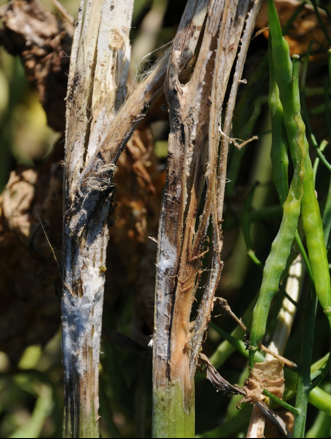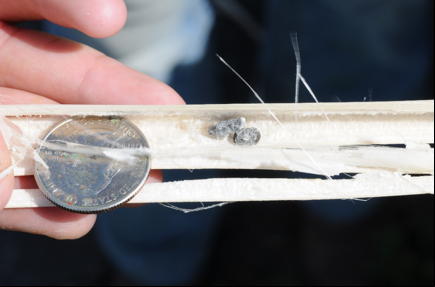As broadleaf crops enter bloom they can become susceptible to white mold infection, says Sam Markell.
However, many factors will help determine how much of a concern white mold will be in field, including; temperature and canopy wetness during bloom, disease history, canopy density and variety susceptibility. As a result, assessing your risk for white mold is very important in managing the disease, says the North Dakota State University plant pathologist.

White mold infection beginning on a sunflower floret, which then landed on the leaf and spread into healthy green tissue.
What are favorable conditions for white mold?
- Broadleaf plants become susceptible to white mold only once they begin blooming (sunflowers are an exception). This is because the pathogen needs to utilize the flowers as a food source to cause infection.
- Soils need to be moist before bloom. Generally, 1-2 inches of rain falling in a 1-2 week period before plants enter bloom is the minimum needed for sclerotia to germinate, produce apothecia, and release ascospores.
- Moderate temperatures and wetness during bloom. High temperatures above 85 degrees F inhibit disease. In years where we hit the 90’s F consistently during bloom, we rarely have white mold. Sclerotinia infection and development is best when daytime highs are cooler; 60’s- 70’s.
- The canopy needs to be wet. Rain, fog, and heavy dews during bloom are all favorable for disease. Paying attention to the long term rain forecast is important if deciding to make a fungicide application.
- Canopy density and canopy closure make a big difference on the environment in the field. Once canopy closure occurs, the crop is likely to have a more favorable environment for infection and disease development.
- Field history can make a difference. Some fields that have a history of white mold, may be more likely to have future epidemics. Importantly, we are taking about field history over long periods of time. Remember, the sclerotia can survive for many years in a field, so an epidemic three years earlier may still be influencing this year’s growing season. Consequently, just because we had a drought last year doesn’t mean we won’t have disease.
- Crop rotation makes a difference. A field with a history or white mold and short rotations among broadleaf crops is more likely to have white mold problems than a field with no white mold history and/or long crop rotations.
- Crop makes a difference. Not all broadleaf crops are equally susceptible to white mold. Sunflowers and dry edible beans consistently seem to be very susceptible, and little resistance is available. Similarly, canola can be hit hard when the environment is favorable. Soybeans can be infected, but they typically do not experience the yield loss the other crops do. Additionally, some varieties of soybean are much less susceptible to white mold than others. Peas can get white mold, but it is less common than other crops.

White mold infection in canola; note tan lesions, white fluffy growth and shredding.
How do you manage white mold with fungicides?
Fungicides can help manage the disease and on some crops they can be very effective. Dry bean applications can be very beneficial in favorable environments; canola application can be as well. Fungicide applications to soybeans are more variable however and favorable economic returns are less common.
Part of the reason is soybeans are naturally less susceptible that dry beans or canola. Sunflower is very susceptible to white mold, but fungicides are not recommended because they are generally not effective at reducing disease.
If you choose to make a fungicide application, timing is very important. Applications made relatively early in the bloom stages are preferred because it helps manage infections that can occur right after the plant enters bloom. In some cases, canopy closure is a very important consideration that may alter timing strategy slightly.
The early infections tend to do the most damage because they have the greatest time to develop through the season. Later applications may also prevent infections, but those later infections do less damage.
Many fungicides are available that have efficacy against white mold. Selection of them will depend on crop, efficacy (which can vary some by crop) and price.
What resources are available?
The canola sclerotinia risk map uses environmental conditions favorable for sclerotinia, so it can be helpful for all broadleaf crops. http://www.ag.ndsu.edu/sclerotinia/
Colorado and Nebraska have developed a fungicide decision checklist for dry beans, found at http://extensionpublications.unl.edu/assets/pdf/g1786.pdf






Post a comment
Report Abusive Comment